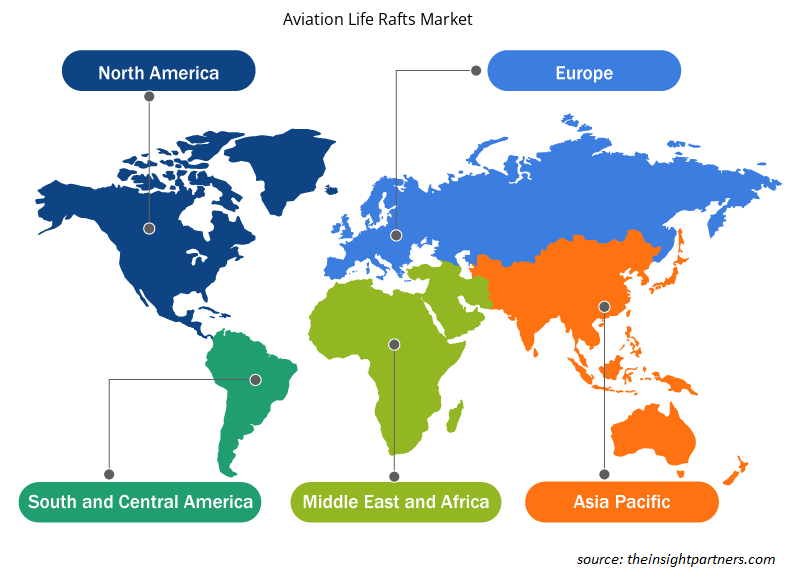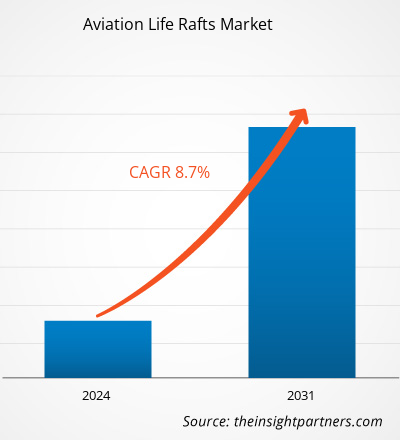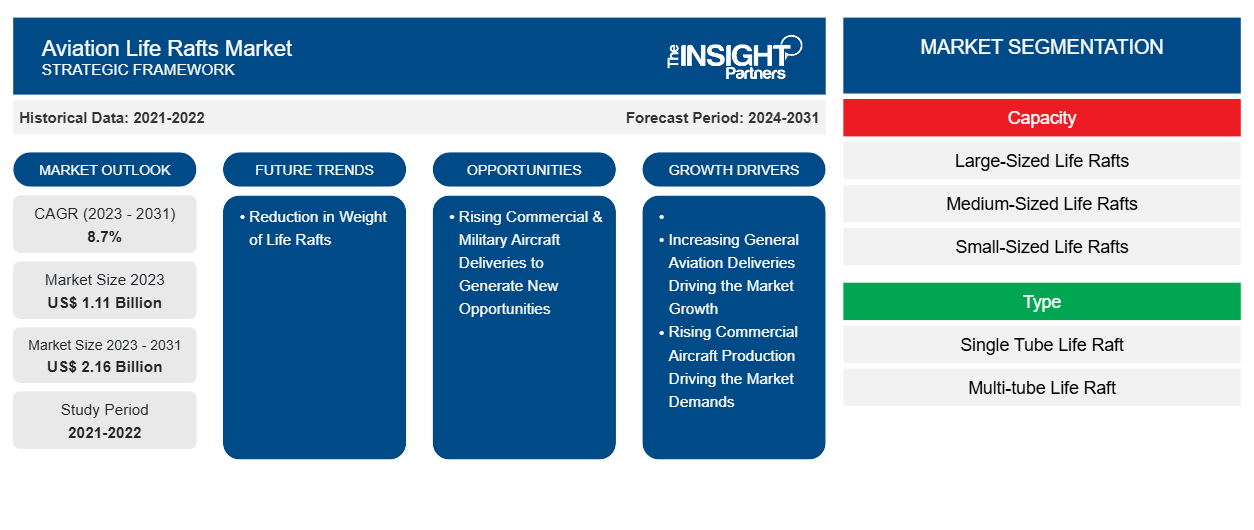Se proyecta que el tamaño del mercado de balsas salvavidas para aviación alcance los 2.160 millones de dólares estadounidenses en 2031, frente a los 1.110 millones de dólares estadounidenses en 2023. Se espera que el mercado registre una CAGR del 8,7 % entre 2023 y 2031. Los actores que operan en el mercado de balsas salvavidas para aviación ofrecen sus productos con una vida útil de más de diez años; sin embargo, la vida útil de las balsas salvavidas está restringida a tres años. La vida útil más corta permite al usuario final montar balsas salvavidas más nuevas cada tres años, lo que beneficia al usuario final al garantizar un inflado suave y un mayor funcionamiento de la balsa durante cualquier percance de aterrizaje en el agua.
Análisis del mercado de balsas salvavidas para aviación
Los principales interesados en el mercado de balsas salvavidas para aviación son los proveedores de material para balsas, los fabricantes de balsas salvavidas para aviación y los usuarios finales. La demanda de balsas salvavidas para aviación es alta, debido a la creciente fabricación de aeronaves y la inversión gubernamental. Las crecientes iniciativas de I+D de varias empresas están complementando aún más el crecimiento del mercado aeroespacial global. En el ecosistema del mercado, el proveedor de material para balsas ofrece varios materiales relacionados con las balsas salvavidas para aviación. Algunos de los proveedores de material para balsas, como Trellborg AB, ContiTech AG y muchos más. El fabricante de balsas salvavidas ofrece diferentes tipos de balsas salvavidas, algunos de los fabricantes presentes en el mercado son Collins Aerospace, Safran, Survitec Group Ltd. y muchos más. Los fabricantes están muy centrados en expandir su base de clientes ofreciendo balsas salvavidas innovadoras para aviación. Los usuarios finales del mercado de balsas salvavidas para aviación adquieren estas balsas salvavidas directamente de los fabricantes. Los usuarios finales en el mercado incluyen fabricantes de aeronaves, fuerzas militares y operadores de aeronaves de aviación general.
Descripción general del mercado de balsas salvavidas para aviación
La demanda de balsas salvavidas para aviación está impulsada principalmente por algunos de los factores mencionados a continuación:
- El aumento de las entregas de aviación general impulsa el crecimiento del mercado
- La creciente producción de aviones comerciales impulsa las demandas del mercado
- Vida útil más corta de las balsas salvavidas de aviación
Estos factores impulsan constantemente el crecimiento del mercado de balsas salvavidas para aviación en diferentes regiones. Algunos de los principales usuarios finales de balsas salvavidas para aviación incluyen fabricantes de equipos originales de aeronaves comerciales y militares, fabricantes de equipos originales de aeronaves de aviación general y regionales y proveedores de mantenimiento, reparación y revisión de aeronaves.
Personalice este informe según sus necesidades
Obtendrá personalización en cualquier informe, sin cargo, incluidas partes de este informe o análisis a nivel de país, paquete de datos de Excel, así como también grandes ofertas y descuentos para empresas emergentes y universidades.
-
Obtenga las principales tendencias clave del mercado de este informe.Esta muestra GRATUITA incluirá análisis de datos, desde tendencias del mercado hasta estimaciones y pronósticos.
Impulsores y oportunidades del mercado de balsas salvavidas para aviación
El aumento de las entregas de aviación general impulsa el crecimiento del mercado
El aumento en el número de entregas de aeronaves de aviación general probablemente impulse el crecimiento del mercado de balsas salvavidas de aviación en diferentes regiones. Según la Asociación de Fabricantes de Aviación General (GAMA), en 2023, se entregaron alrededor de 3.050 unidades de aviones de aviación general en diferentes regiones. Las entregas de aviación general experimentaron un crecimiento del 9% en 2023 en comparación con 2022. Además, hay al menos dos balsas salvavidas en cada uno de los aviones de aviación general que están certificados según las normas FAA TSO-C70a. Por otro lado, las entregas de aeronaves con motor de pistón experimentaron un crecimiento continuo del 11,8% (1.682 entregas) en 2023; los jets comerciales experimentaron un aumento en el número de entregas que ascendieron a 730 unidades en 2023 en comparación con 712 unidades en 2022. Estos factores están impulsando el crecimiento del mercado de balsas salvavidas de aviación en todo el mundo.
El aumento de las entregas de aviones comerciales y militares generará nuevas oportunidades
El creciente número de entregas de aviones comerciales es uno de los principales factores que probablemente generen nuevas oportunidades para los vendedores del mercado durante el período de pronóstico. Las entregas esperadas de aviones comerciales durante los próximos 20 años probablemente generen nuevas oportunidades para los vendedores de balsas salvavidas de aviación en los próximos años. Según varias fuentes de aviación, se espera que se entreguen más de 40.000 nuevos aviones comerciales durante 2042. Además, la esperada adquisición de aviones militares es otro factor importante que probablemente brinde nuevas oportunidades para los fabricantes de balsas salvavidas en los próximos años. Esto también está respaldado por los conflictos en curso entre varios países como Rusia-Ucrania, Israel-Palestina e Israel-Irán que han generado conciencia entre diferentes naciones para aumentar sus respectivas fortalezas militares. Para esto, diferentes países han estado brindando varios contratos a fabricantes de aviones militares para varios tipos de aeronaves, incluidos aviones de combate, aviones de vigilancia, aviones de carga y también aviones cisterna de reabastecimiento aéreo. Estos factores también han estado impulsando el despliegue de balsas salvavidas en el segmento de aviones militares.
Análisis de segmentación del informe de mercado de balsas salvavidas para aviación
Los segmentos clave que contribuyeron a la derivación del análisis del mercado de balsas salvavidas de aviación son la capacidad, el tipo, la aplicación y la geografía.
- En función de la capacidad, el mercado se ha segmentado en balsas salvavidas de gran tamaño, balsas salvavidas de tamaño mediano y balsas salvavidas de tamaño pequeño. El segmento de balsas salvavidas de gran tamaño tuvo una mayor participación de mercado en 2023.
- Por tipo, el mercado se ha segmentado en balsas salvavidas de un solo tubo y balsas salvavidas de varios tubos. El segmento de balsas salvavidas de varios tubos tuvo la mayor participación del mercado en 2023.
- En términos de aplicación, el mercado se ha segmentado en aviación general, aviación militar/defensa y aviación comercial. El segmento de aviación general dominó el mercado en 2023.
Análisis de la cuota de mercado de las balsas salvavidas para aviación por geografía
El alcance geográfico del informe del mercado de balsas salvavidas de aviación se divide principalmente en cinco regiones: América del Norte, Europa, Asia Pacífico, Medio Oriente y África, y América del Sur.
América del Norte ha dominado el mercado de balsas salvavidas de aviación en 2023, mientras que es probable que la región de Asia Pacífico sea testigo de un crecimiento significativo durante el período de pronóstico. Estados Unidos representó una mayor participación de mercado en el mercado de balsas salvavidas de aviación de América del Norte. Esto se debe principalmente a la presencia de varios fabricantes de balsas salvavidas de aviación en el país, a saber: EAM Worldwide, Life Support International, Inc., Revere Survival Inc., AVI Aviation y Collins Aerospace, entre otros, es una de las razones importantes para el crecimiento de las balsas salvavidas de aviación en el país. Además, el gasto militar del país es uno de los más altos del mundo, lo que respalda el desarrollo de la flota de aviones militares más grande, impulsando así el mercado en los EE. UU. Además, la presencia de los principales fabricantes de aviones de aviación general como Northrop Grumman y Raytheon Technologies, entre otros, exige la integración de balsas salvavidas y deslizadores de evacuación en estos aviones.
Perspectivas regionales del mercado de balsas salvavidas para aviación
Los analistas de Insight Partners explicaron en detalle las tendencias y los factores regionales que influyen en el mercado de balsas salvavidas para aviación durante el período de pronóstico. Esta sección también analiza los segmentos y la geografía del mercado de balsas salvavidas para aviación en América del Norte, Europa, Asia Pacífico, Oriente Medio y África, y América del Sur y Central.

- Obtenga datos regionales específicos para el mercado de balsas salvavidas para aviación
Alcance del informe sobre el mercado de balsas salvavidas para aviación
| Atributo del informe | Detalles |
|---|---|
| Tamaño del mercado en 2023 | 1.110 millones de dólares estadounidenses |
| Tamaño del mercado en 2031 | US$ 2.16 mil millones |
| CAGR global (2023 - 2031) | 8,7% |
| Datos históricos | 2021-2022 |
| Período de pronóstico | 2024-2031 |
| Segmentos cubiertos |
Por capacidad
|
| Regiones y países cubiertos |
América del norte
|
| Líderes del mercado y perfiles de empresas clave |
|
Densidad de actores del mercado de balsas salvavidas para aviación: comprensión de su impacto en la dinámica empresarial
El mercado de balsas salvavidas para aviación está creciendo rápidamente, impulsado por la creciente demanda de los usuarios finales debido a factores como la evolución de las preferencias de los consumidores, los avances tecnológicos y una mayor conciencia de los beneficios del producto. A medida que aumenta la demanda, las empresas amplían sus ofertas, innovan para satisfacer las necesidades de los consumidores y aprovechan las tendencias emergentes, lo que impulsa aún más el crecimiento del mercado.
La densidad de actores del mercado se refiere a la distribución de las empresas o firmas que operan dentro de un mercado o industria en particular. Indica cuántos competidores (actores del mercado) están presentes en un espacio de mercado determinado en relación con su tamaño o valor total de mercado.
Las principales empresas que operan en el mercado de balsas salvavidas para aviación son:
- EAM en todo el mundo
- Soporte Vital Internacional, Inc.
- Revere Supervivencia Inc.
- Grupo Safran
- Grupo Survitec Limitada
- Aviación AVI
Descargo de responsabilidad : Las empresas enumeradas anteriormente no están clasificadas en ningún orden particular.

- Obtenga una descripción general de los principales actores clave del mercado de balsas salvavidas de aviación
Noticias y desarrollos recientes del mercado de balsas salvavidas para aviación
El mercado de balsas salvavidas para aviación se evalúa mediante la recopilación de datos cualitativos y cuantitativos posteriores a la investigación primaria y secundaria, que incluye publicaciones corporativas importantes, datos de asociaciones y bases de datos. A continuación, se incluye una lista de los avances en el mercado de balsas salvavidas para aviación y las estrategias:
- En julio de 2023, AVI Survival Products lanzó la nueva balsa salvavidas reversible para 6 pasajeros. El producto está equipado con un sistema de inflado automático activado manualmente con un cordón y garantiza una respuesta rápida cuando sea necesario. El sistema de inflado consta de un cilindro compuesto cargado con N2/CO2, un manómetro y una válvula de inflado. Además, la balsa salvavidas reversible viene con un cuchillo para balsa con un diseño de hoja empotrada, una cuerda salvavidas que rodea el perímetro exterior de la balsa, un toldo que se puede erigir después de abordar, una cuerda y un anillo de elevación almacenados en una bolsa ignífuga, una maleta de balsa/ancla de mar de doble propósito especialmente diseñada, ayudas para el abordaje ubicadas estratégicamente, conjunto de bomba manual y un kit de equipo completo. (Fuente: FCAH Aerospace, comunicado de prensa/sitio web de la empresa/boletín informativo)
- En marzo de 2022, Survitec presentó una "balsa salvavidas monoplaza más pequeña y ligera" (SSLR, por sus siglas en inglés) para equipar mejor a los pilotos de aviones militares de reacción rápida en misiones más desafiantes o cuando se ven obligados a eyectarse de su avión sobre el agua. (Fuente: Comtek Advanced Structures Ltd, comunicado de prensa/sitio web de la empresa/boletín informativo)
Informe sobre el mercado de balsas salvavidas para aviación: cobertura y resultados
El informe “Tamaño y pronóstico del mercado de balsas salvavidas para aviación (2021-2031)” proporciona un análisis detallado del mercado que cubre las siguientes áreas:
- Tamaño del mercado y pronóstico a nivel global, regional y nacional para todos los segmentos clave del mercado cubiertos bajo el alcance
- Dinámica del mercado, como impulsores, restricciones y oportunidades clave
- Principales tendencias futuras
- Análisis detallado de las cinco fuerzas de Porter
- Análisis del mercado global y regional que cubre las tendencias clave del mercado, los principales actores, las regulaciones y los desarrollos recientes del mercado.
- Análisis del panorama de la industria y de la competencia que abarca la concentración del mercado, el análisis de mapas de calor, los actores destacados y los desarrollos recientes
- Perfiles de empresas detallados con análisis FODA
- Análisis histórico (2 años), año base, pronóstico (7 años) con CAGR
- Análisis PEST y FODA
- Tamaño del mercado, valor/volumen: global, regional y nacional
- Industria y panorama competitivo
- Conjunto de datos de Excel
Informes recientes
Testimonios
Razón para comprar
- Toma de decisiones informada
- Comprensión de la dinámica del mercado
- Análisis competitivo
- Información sobre clientes
- Pronósticos del mercado
- Mitigación de riesgos
- Planificación estratégica
- Justificación de la inversión
- Identificación de mercados emergentes
- Mejora de las estrategias de marketing
- Impulso de la eficiencia operativa
- Alineación con las tendencias regulatorias























 Obtenga una muestra gratuita para - Mercado de balsas salvavidas para aviación
Obtenga una muestra gratuita para - Mercado de balsas salvavidas para aviación